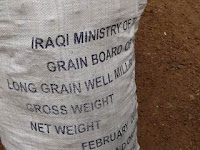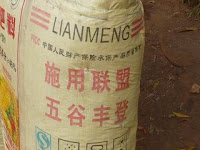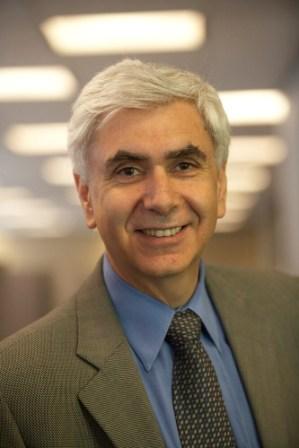
It’s comforting to know that people out there are thinking of me. A few have commented that there appears to be a diminishing amount of me. Pictured here is taken last weekend in Freetown with the VSO country director, Chals Wontonwe. Well it is true that my trouser belt is a couple of notches further in but I seem to be able to have a balanced diet although without the added Mars Bar calories. The food markets have a very limited selection of “western food” and there is a complete lack of any Loblaws or Sainsburys type supermarkets. Kelloggs and Cadburys type stuff can be bought in the west of Freetown where most of the international NGO’s have their compounds and the foods are quite expensive. Makeni clearly doesn’t make it; the nearest thing being the PZ petrol filling station that also has a selection of canned tuna, mayonnaise, pasta for the Italian priests,
that also has a selection of canned tuna, mayonnaise, pasta for the Italian priests, laughing cow cheese and occasionally some jam. In the town there is quite a lot of bread made and sold by the Fullah tribesmen from stalls along the road.
laughing cow cheese and occasionally some jam. In the town there is quite a lot of bread made and sold by the Fullah tribesmen from stalls along the road.  They know me now and I try to distribute my trade among them. The staple diet among Saloneans here is rice and no matter how much other food is consumed, people will say that they have not eaten unless rice has been on the plate. More about rice later.
They know me now and I try to distribute my trade among them. The staple diet among Saloneans here is rice and no matter how much other food is consumed, people will say that they have not eaten unless rice has been on the plate. More about rice later.  Most of the vegetable food is available from stalls in the market and there appears to be a good supply but of very limited variety.
Most of the vegetable food is available from stalls in the market and there appears to be a good supply but of very limited variety.
Having adapted now to the local foods my diet has certainly changed and I eat a combination of rice dishes with locally grown vegetables mainly cassava, sweet potato, crin crin including and sometimes solely the leaves.  There are no fridges here – no electricity – and the hot climate means that all the food you buy has to be eaten. Groundnuts are locally grown and I have a favourite fellow in the market who will grind the nuts into a paste; much like peanut butter. I favour those dishes that I can cook in ½ hour and over a single kerosene stove ‘cause that’s all I have. So I make cassava leaves mixed with groundnut paste and a good helping of fresh peppers, sweet potatoes etc.
There are no fridges here – no electricity – and the hot climate means that all the food you buy has to be eaten. Groundnuts are locally grown and I have a favourite fellow in the market who will grind the nuts into a paste; much like peanut butter. I favour those dishes that I can cook in ½ hour and over a single kerosene stove ‘cause that’s all I have. So I make cassava leaves mixed with groundnut paste and a good helping of fresh peppers, sweet potatoes etc.  Also an easy one is Jollof rice, a sort of dahl made with lentils and sweet potatoes. A gourd known as pumkin, tasting quite unlike the Canadian pumpkin is nice with tomato paste. I must admit that my waistline is smaller but I feel more healthy without the western sweets and sugary foods.
Also an easy one is Jollof rice, a sort of dahl made with lentils and sweet potatoes. A gourd known as pumkin, tasting quite unlike the Canadian pumpkin is nice with tomato paste. I must admit that my waistline is smaller but I feel more healthy without the western sweets and sugary foods.
It is a sad day though. Today was the first day that I was not able to buy my regular supply of grapefruit. For 4 months this has been one of my comfort foods and the locally grown fruit has been delicious but the season is over I am told. I have tried some substitutes and an interesting one is the cashew fruit. This is a strange looking fruit that is available for about 200 leones (10c) each and is about the size of a small apple. The juice is very sweet and syrupy and takes getting used to. The kidney shaped cashew nut at one end is roasted and like most people I’ve only ever seen these in a tin at Loblaws. The mangoes are about to ripen on the tree near my house and I’ll see if I can adapt from the sharp sweet tasting grapefruit. Coming into season however is pineapple and I cant wait.
A new development has occurred over the past couple of weeks where a small stall strangely located at the back of a straw football game showing hut, has a trader that sells fresh European  vegetables, runner beans, tomatoes, cabbage and even carrots. The farmer himself travels to Makeni from a place called Kabala in the hills about 1.5 hours away where the climate is cooler and where the vegetables can be grown. The farmer is only here on a Monday and Friday mornings. These familiar vegetables are unusual looking African sights that have caught the eye of the various NGO types and the Lebanese. It is amazing that a lowly runner bean and a cabbage can look so appealing. The Kabala farmer is doing a roaring trade among the non-Africans, selling all his produce but to the average Salonean population a single small cabbage for 1000 leones is just too expensive. By contrast a huge sheaf of cassava leaves is about 100 leones.
vegetables, runner beans, tomatoes, cabbage and even carrots. The farmer himself travels to Makeni from a place called Kabala in the hills about 1.5 hours away where the climate is cooler and where the vegetables can be grown. The farmer is only here on a Monday and Friday mornings. These familiar vegetables are unusual looking African sights that have caught the eye of the various NGO types and the Lebanese. It is amazing that a lowly runner bean and a cabbage can look so appealing. The Kabala farmer is doing a roaring trade among the non-Africans, selling all his produce but to the average Salonean population a single small cabbage for 1000 leones is just too expensive. By contrast a huge sheaf of cassava leaves is about 100 leones.
The absence of locally grown rice is really intriguing.  The stalls and small shopkeepers sell huge 25 kg bags of rice costing about 70,000 leones that is only bought by better off Saloneans. Most rice is sold by the cup (less than 1/8 kg for 500 Le.) from the ladies in the market
The stalls and small shopkeepers sell huge 25 kg bags of rice costing about 70,000 leones that is only bought by better off Saloneans. Most rice is sold by the cup (less than 1/8 kg for 500 Le.) from the ladies in the market  and at almost double the bag price. The poor suffer as usual but I am intrigued that little if any is locally grown despite the accommodating wet climate in the rainy season.
and at almost double the bag price. The poor suffer as usual but I am intrigued that little if any is locally grown despite the accommodating wet climate in the rainy season.
Chatting with the shopkeepers reveals that a whole selection of rice in their stores is from around the world, India, Thailand, China, Bangladesh as well as from Uncle Sam, Italy and other European countries. Even charity bags that explicitly state “not for re-sale” are openly sold. My travels to Freetown and across to Bo and Kenema have revealed large areas of uncultivated land that appear to my untrained eye to be suitable for rice growing. Low lying and swampy land. My intrigue has driven me to talk to the local farmers associations; usually organized through an NGO.
My travels to Freetown and across to Bo and Kenema have revealed large areas of uncultivated land that appear to my untrained eye to be suitable for rice growing. Low lying and swampy land. My intrigue has driven me to talk to the local farmers associations; usually organized through an NGO.
It appears that the only rice that is farmed is almost solely for subsistence. There is no mechanization at all and the rice fields that I saw all have manual workers. Further chatting with some of the more enlightened farmers reveals that fertilizer is too expensive since it is imported. Cattle are very few in this country. A report from the European NGO Action Faim states - according to our nutritional assessment, 25 % of the population is not eating enough during more than 6 months of the year. They are the vulnerable households. Their farming system is not performing enough to feed them for more than a few months in the year. The general farming system of the District (the country…) is unable to reach self-sufficiency in terms of rice, the staple food .
.
I came across a book in the Fatima Institute library that told me that rice used to be grown commercially up until the 1980’s. However after that time the huge devaluation of the currency meant that all imported fertilizer and machinery plus parts became enormously expensive. Also the ore and minerals formerly exported suffered because the world prices collapsed. At the same time the World Bank decided to help out by subsidizing imported rice, a policy that appears to be very laudable rather than risking a famine. The 10 year civil war here also did much to destroy any infrastructure and market system and it is understandable that help from outside the country was needed. It is now however 6 years since the war ended.
Also the ore and minerals formerly exported suffered because the world prices collapsed. At the same time the World Bank decided to help out by subsidizing imported rice, a policy that appears to be very laudable rather than risking a famine. The 10 year civil war here also did much to destroy any infrastructure and market system and it is understandable that help from outside the country was needed. It is now however 6 years since the war ended.
What has happened is that the imported rice has been subsidized to such a degree and for a long term (over 15 years) such that the local commercial farmers have been unable to compete and skills are lost. The alarming result is that there is now only subsistence farming but where rice is a staple diet.  The paradox is that Saloneans almost always eat their staple diet of rice bought by “the west” from the Bangladeshi or Thai farmer and to the detriment of the domicile Salonean farmers.
The paradox is that Saloneans almost always eat their staple diet of rice bought by “the west” from the Bangladeshi or Thai farmer and to the detriment of the domicile Salonean farmers.  There is perhaps more to this ridiculous situation that is somehow hidden and one logically thinks that this must be a mistake. Surely someone has to realize that this can not be made to persist and that Saloneans should be able to feed themselves?
There is perhaps more to this ridiculous situation that is somehow hidden and one logically thinks that this must be a mistake. Surely someone has to realize that this can not be made to persist and that Saloneans should be able to feed themselves?  Why doesnt the World Bank subsidise the local Salonean farmers? Surely if it is good to subsidise the American, French and British farmers to produce butter, and the Bangladeshis to produce rice, why not the lowly Saloneans?
Why doesnt the World Bank subsidise the local Salonean farmers? Surely if it is good to subsidise the American, French and British farmers to produce butter, and the Bangladeshis to produce rice, why not the lowly Saloneans?
Perhaps when next eating at your favourite restaurant, demand rice from Sierra Leone.





# posted by Fishing @ 6:06 PM


























